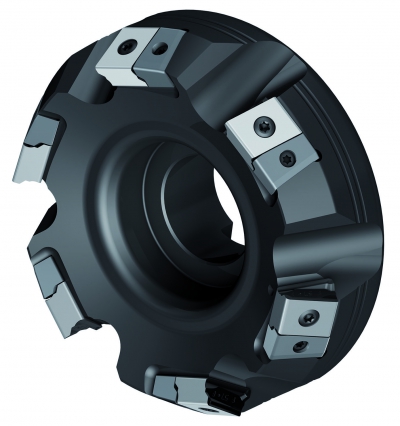
Walter has introduced the Walter BLAXX M3016, a heavy-duty milling cutter with the ruggedness and power needed to make heavy cuts seem easy. The M3016 tackles ISO material groups P, M and K, and difficult applications such as machining frames made from cast iron for large molds, or housings for wind energy rotor hubs.
In addition, the M3016, which is aimed chiefly at milling and boring machines, delivers superior process reliability even with older machines, according to the company. These and other advantages derive from a number of factors, such as the M3016’s carbide axial stop for high process reliability. This works as an emergency cutting edge to protect the clamping screw and insert pocket from damage, reducing tooling costs in the process. Additionally, the M3016 uses four grades of Walter’s advanced Tigeṙ·tec Silver cutting tool material: WKP25S, WKP35S (CVD) and WKK25S, WSP45S (PVD), which boosts both tool life and process reliability, while also reducing cutting material costs.
The M3016 is available with an approach angle of 60° for diameter range 4.9 to 12.4 in. (125-315 mm). One insert style simplifies administrative tasks allowing both time and money to be saved. Additional diameters and lead angles can easily be obtained by ordering through Walter Xpress, the company’s short lead time service for specials.
Contact Details
Related Glossary Terms
- approach angle
approach angle
Angle between the insert’s side-cutting edge and the line perpendicular to the milling cutter’s axis of rotation. Approach angle, which is also known as cutting edge angle, is used with metric units of measurement. See lead angle.
- boring
boring
Enlarging a hole that already has been drilled or cored. Generally, it is an operation of truing the previously drilled hole with a single-point, lathe-type tool. Boring is essentially internal turning, in that usually a single-point cutting tool forms the internal shape. Some tools are available with two cutting edges to balance cutting forces.
- gang cutting ( milling)
gang cutting ( milling)
Machining with several cutters mounted on a single arbor, generally for simultaneous cutting.
- milling
milling
Machining operation in which metal or other material is removed by applying power to a rotating cutter. In vertical milling, the cutting tool is mounted vertically on the spindle. In horizontal milling, the cutting tool is mounted horizontally, either directly on the spindle or on an arbor. Horizontal milling is further broken down into conventional milling, where the cutter rotates opposite the direction of feed, or “up” into the workpiece; and climb milling, where the cutter rotates in the direction of feed, or “down” into the workpiece. Milling operations include plane or surface milling, endmilling, facemilling, angle milling, form milling and profiling.
- milling cutter
milling cutter
Loosely, any milling tool. Horizontal cutters take the form of plain milling cutters, plain spiral-tooth cutters, helical cutters, side-milling cutters, staggered-tooth side-milling cutters, facemilling cutters, angular cutters, double-angle cutters, convex and concave form-milling cutters, straddle-sprocket cutters, spur-gear cutters, corner-rounding cutters and slitting saws. Vertical cutters use shank-mounted cutting tools, including endmills, T-slot cutters, Woodruff keyseat cutters and dovetail cutters; these may also be used on horizontal mills. See milling.







